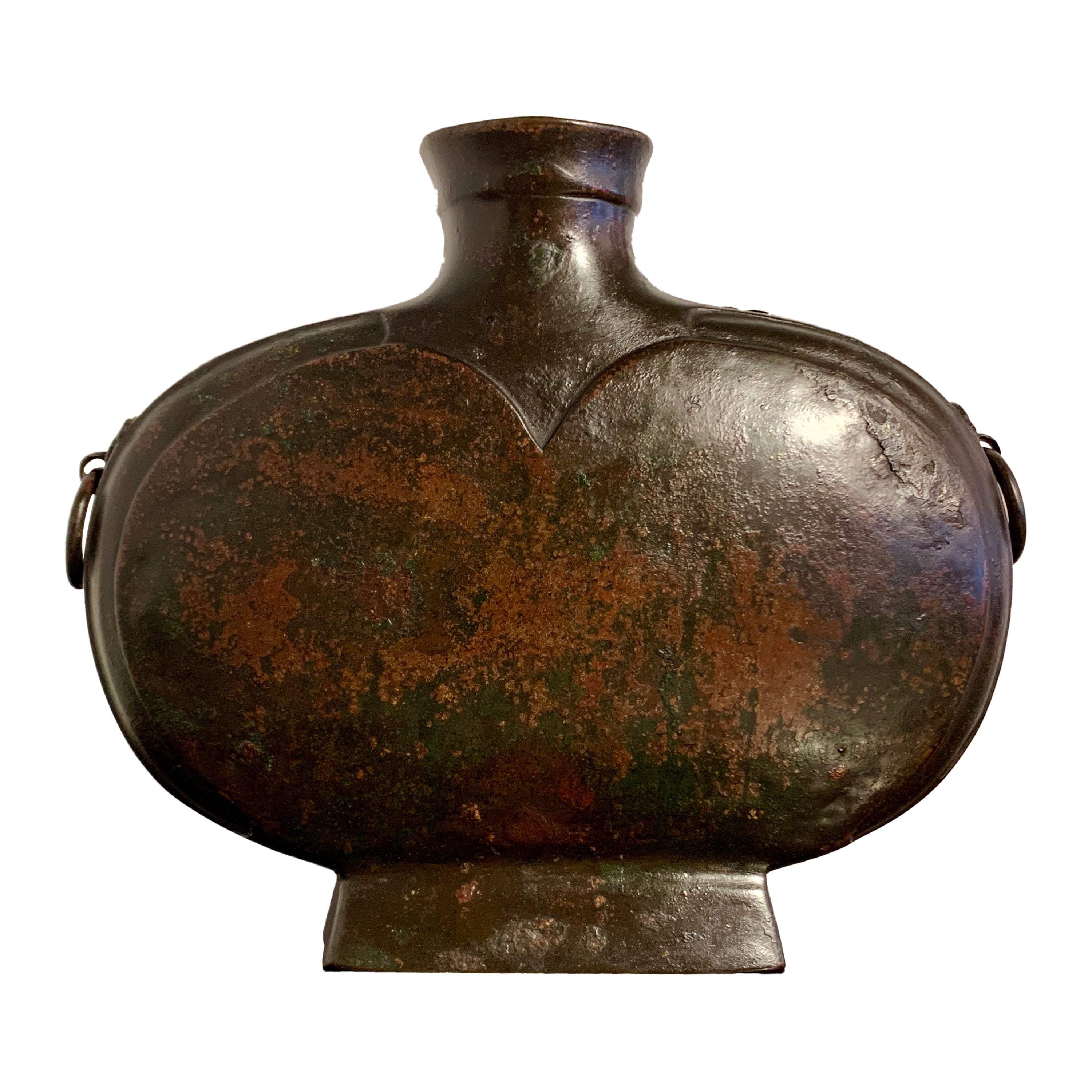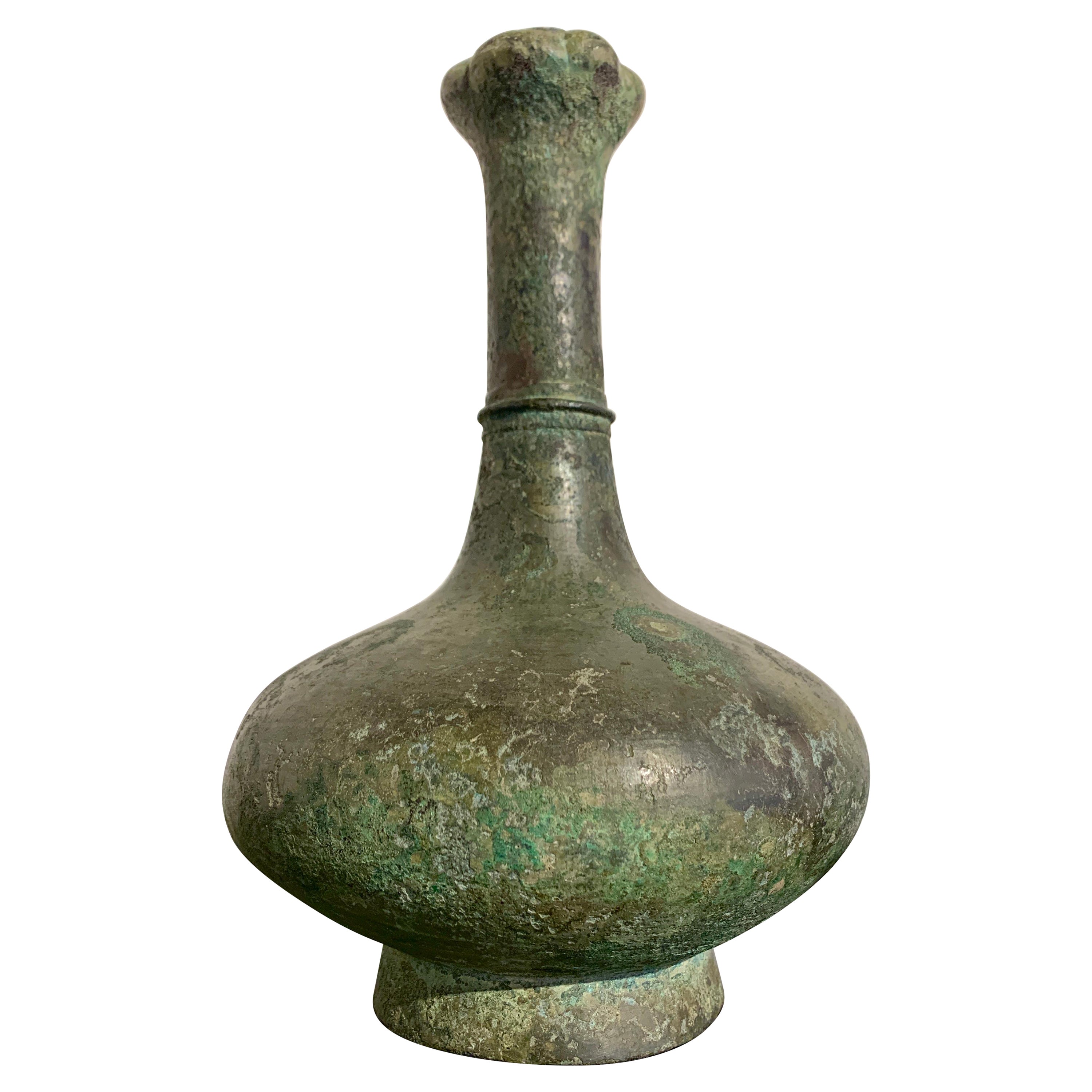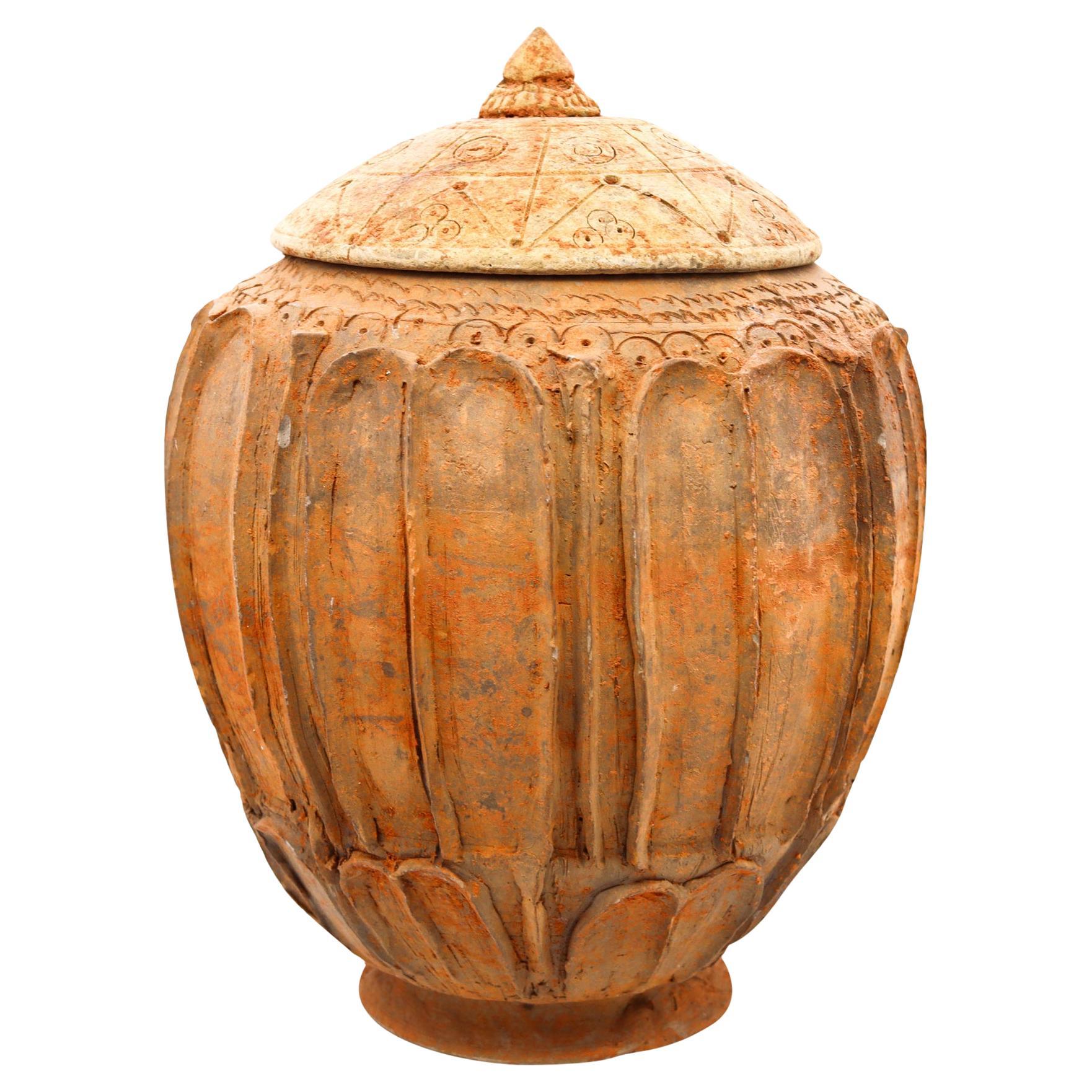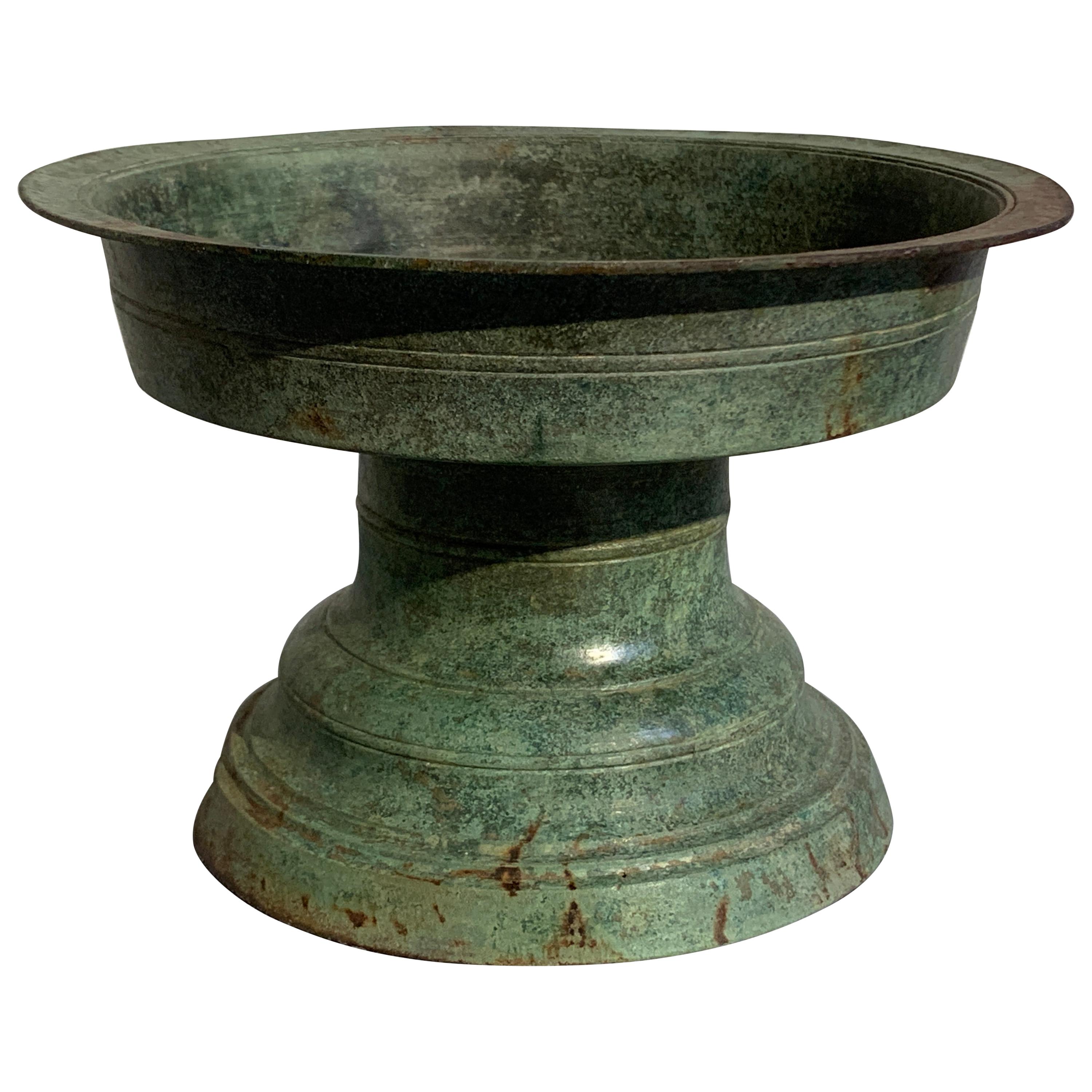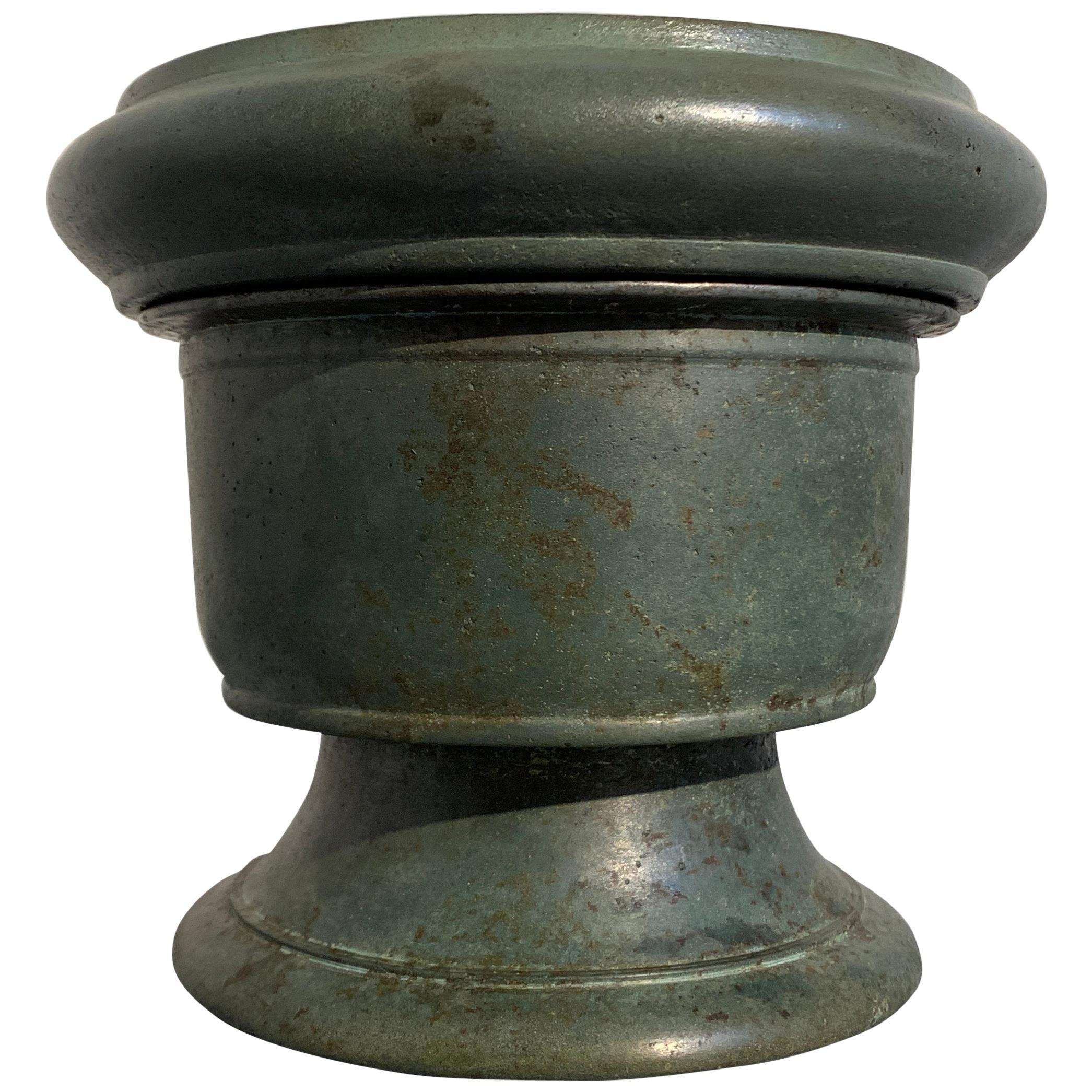Items Similar to China 960 Ad Song Dynasty Very Rare Imperial Period Offering Vessel in Bronze
Want more images or videos?
Request additional images or videos from the seller
1 of 6
China 960 Ad Song Dynasty Very Rare Imperial Period Offering Vessel in Bronze
About the Item
Offering vessel from the Chinese Song Dynasty (960/1279 AD ).
A beautiful "offering spiritual vessel" from the Yunnan province region in the ancient China. This rare vessel was created in red bronze during the Song Dynasty period. between 960/1279 AD.
This is one of the most unusual forms of red bronze jar. A large vessel, the sides are virtually perpendicular to the base. The stepped lid design is also among the more rare types. The predominant lid design among the Yunnan offering bronzes is the "wheel" pattern, with a few lids having the lotus design. This is also one of the few bronzes displaying clear riveting of a two-part vessel body, with the original twisted elements
Has a combined measures including the lid of 12.5 by 8.75 inches (31.75 x 22,23 Cm).
The Song Dynasty, was an imperial dynasty of China that began in 960 and lasted until 1279. The dynasty was founded by Emperor Tizu of Song following his usurpation of the throne of the later Zhou, ending the Five-Dynasties and Ten Kingdoms period. The Song often came into conflict with the contemporaneous Liao, Western Xia and Jin dynasties in northern China. After decades of armed resistance defending southern China, it was eventually conquered by the Mongol-led Yuan dynasty.
The dynasty is divided into two periods: Northern Song and Southern Song. During the northern Song, the capital was in the northern city of Bianqing and the dynasty controlled most of what is now Easter China. The Southern Song, refer to the period after the Song lost control of its northern half to the Jurchen-led Jin dynasty in the Sin-Song wars. At that time, the Song court retreated south of the Yangtze and established its capital at Lin’an. Although the Song dynasty had lost control of the traditional Chinese heartlands around the yellow river, the Southern Song Empire contained a large population and productive agricultural land, sustaining a robust economy. In 1234, the Jin dynasty was conquered by the Mongols, who took control of northern China, maintaining uneasy relations with the Southern Song.
Note: These types of jars were originally excavated from Buddhist sites in the region of Yunnan, China. Used to hold sutras, dedications, or offerings, they were usually buried at the bases of temples, pagodas, or other holy sites.
Collateral: An actual letter, dated October 1, 2021 from TK Asian Antiquities Gallery, signed by Michael Teller, accompanied this piece as a certificate of authenticity. Copy of the book will be included.
Provenance: A private collection in New York city collected in the 1964; T.K. Asian Antiquities Gallery, Williamsburg Virginia; A private collection in Palm Beach FL; then purchased by James & Nancy Markell, Virginia 1976; then by descent to Lauren Markland, Fort Lauderdale, FL.; acquired in Palm Beach, FL. in march 7, 2021.
Literature: Offering Vessels of Yunnan, Michael C, Teller IV. T.K. Asian Antiquities Gallery, New York 2004. Illustrated Pp-51.
It is in nice ancient condition, with all parts original from the period.
INVENTORY REF: D0000ANNM/.1112.
- Dimensions:Height: 12.5 in (31.75 cm)Width: 8.5 in (21.59 cm)Depth: 8.5 in (21.59 cm)
- Style:Medieval (Of the Period)
- Materials and Techniques:
- Place of Origin:
- Period:
- Date of Manufacture:960-1279 AD
- Condition:Wear consistent with age and use. It is in nice ancient condition, with all parts original from the period. Literature: Offering Vessels of Yunnan, Michael C, Teller IV. T.K. Asian Antiquities Gallery, New York 2004. Illustrated Pp-51.
- Seller Location:Miami, FL
- Reference Number:
About the Seller
5.0
Platinum Seller
These expertly vetted sellers are 1stDibs' most experienced sellers and are rated highest by our customers.
1stDibs seller since 2023
63 sales on 1stDibs
Typical response time: <1 hour
- ShippingRetrieving quote...Ships From: Miami, FL
- Return PolicyA return for this item may be initiated within 1 day of delivery.
More From This SellerView All
- China 618-907 AD Tang Dynasty Period Pottery Offering Covered Vessel with LotusLocated in Miami, FLOffering vessel from the Chinese Tang Dynasty (618-907 AD). A beautiful "offering spiritual vessel" from the Yunnan province region in the ancient China. This was created in clay earthenware pottery during the Tang Dynasty period between 618 and 907 AD. Featuring molded patterns with incised and high reliefs of geometric figures. The design consists of the bombe baluster-shaped jug and a lid with a spherical knob, which are decorated in relief with 8 panels representing the petals of the lotus flower and linear geometric designs. Has a combined measures including the lid of 10.25 by 7.5 inches (26..03 x 19.05 Cm). Tang dynasty or Tang Empire, was an imperial dynasty of China that ruled from 618 to 907, with an interregnum between 690 and 705. It was preceded by the Sui dynasty and followed by the Five Dynasties and Tend Kingdoms period. Historians generally regard the Tang as a high point in Chinese civilization, and a the golden age of cosmopolitan culture. Tang territory, acquired through the military campaigns of its early rulers, rivaled that of the Han dynasty. The Li family founded the dynasty, seizing power during the decline and collapse of the Sui Empire and inaugurating a period of progress and stability in the first half of the dynasty's rule. The dynasty was formally interrupted during 690–705 when Empress Wu Zetian seized the throne, proclaiming the Wu Zhou dynasty...Category
Antique 15th Century and Earlier Chinese Tang Antiquities
MaterialsClay, Earthenware, Pottery
- China 618-907 AD Tang Dynasty Offering Vessel With 8 Lotus Petals in EarthenwareLocated in Miami, FLOffering vessel from the Chinese Tang Dynasty (618-907 AD). A beautiful "offering spiritual vessel" from the Yunnan province region in the ancient China. This was created in clay earthenware pottery during the Tang Dynasty period between the 618 and 907 AD. Featuring finely molded patterns with incised and high reliefs of geometric figures. The design consists of the bombe round-shaped jar and a lid with a conical knob, which are decorated in relief with one single layer of finely sculpted 8 lotus petals. The lid is decorated with geometric figures and the knob in the lid is plain, topped by a form known as a vase. Has a combined measures including the lid of 8.25 by 7 inches (20.95 x 17.78 Cm). Tang dynasty or Tang Empire, was an imperial dynasty of China that ruled from 618 to 907, with an interregnum between 690 and 705. It was preceded by the Sui dynasty and followed by the Five Dynasties and Tend Kingdoms period. Historians generally regard the Tang as a high point in Chinese civilization, and a the golden age of cosmopolitan culture. Tang territory, acquired through the military campaigns of its early rulers, rivaled that of the Han dynasty. The Li family founded the dynasty, seizing power during the decline and collapse of the Sui Empire and inaugurating a period of progress and stability in the first half of the dynasty's rule. The dynasty was formally interrupted during 690–705 when Empress Wu Zetian seized the throne, proclaiming the Wu Zhou dynasty...Category
Antique 15th Century and Earlier Chinese Tang Antiquities
MaterialsEarthenware, Pottery
- China 549-577 AD Northern Qi Dynasty Ancient Caparisoned Horse in EarthenwareLocated in Miami, FLExtremely rare Chinese pottery caparisoned horse from the Northern Qi region. A beautiful large sculptural piece, created in China during the Northern Qi dynasty period, between the 549 and 577 AD. This horse statue is extremely finely modeled of earthenware pottery, standing in a very elegant and majestic position striding on a trapezoidal shaped base. The animal has a gracefully arched neck to the left looking forward and its extremely well modeled. The head is adorned with a large detailed tassels of plumes and the body is embellished with a beautiful saddle and intricate harnesses. The trapping around the chest and rump is adorned with elaborated tassels and the straps are accented with multiples florets and bosses in high relief. Decorated with dotted and circles patterns. The surface is treated with applications of natural color pigments such; red, white and others. Has a measurements of 435 mm by 319 mm by 243 mm (17.10 x 12.55 x 9.55 Inches) (43.5 x 31.9 x 24.3 Cm). Northern Qi, was the successor state of the Chinese Xianbei state of Eastern Wei...Category
Antique 15th Century and Earlier Chinese Archaistic Antiquities
MaterialsEarthenware, Clay, Paint
- China 549-577 AD Northern Qi Dynasty Ancient Caparisoned Horse In EarthenwareLocated in Miami, FLExceedingly rare Chinese pottery caparisoned horse from the Northern Qi region. A beautiful sculptural piece, created in China during the Northern Qi dynasty period, between the 549 and 577 AD. This horse statue is extremely finely modeled of earthenware pottery, standing in a very elegant and majestic position striding on a trapezoidal shaped base. The animal has a gracefully arched neck to the left and its extremely well modeled. The head is adorned with a large detailed tassels of plumes and the body is embellished with a beautiful saddle and intricate harnesses. The trapping around the chest and rump is adorned with elaborated tassels and the straps are accented with multiples florets and bosses in high relief. The surface is treated with applications of natural pigments such; red, white and others. Has a measurements of 394 mm by 343 mm by 257 mm (15.53 x 13.52 x 10.15 Inches) (39.4 x 34.3 x 25.7 Cm). Northern Qi, was the successor state of the Chinese Xianbei state of Eastern Wei...Category
Antique 15th Century and Earlier Chinese Archaistic Sculptures and Carvings
MaterialsEarthenware, Pottery
- China 618-907 AD Tang Dynasty Pair Of Polychromate Earth Spirits ZhenmushouLocated in Miami, FLPair of Earths Spirits "Zhenmushou" from the China Tang Dynasty 618-907 AD. A beautiful and rare pair of "Earths Spirits guardians" from the Yunnan province region in the ancient China. This was created in clay earthenware pottery during the Tang Dynasty period between 618 and 907 AD. Featuring the molded figures of two seated guardians with decorations with polychrome pigmentations. The figures are seated on their haunches with cloven hooves planted firmly on the base looking forward with their front legs in a straight position. Both with face and body alert expressions on a rectangular base. Earth spirits usually appear in pairs, one with a human head and the other with a lion head. Their supernatural powers, indicated by antlers, spiky flanges and flames, enable them to confront evil spirits and protect any precincts within their gaze. Have been believed to protect the living by keeping the spirits of the dead from inappropriately roaming the world outside the tomb. Zhenmushou or guardian deities, developed from a line of protective spirits found normally in pairs at the front of Tang dynasty tombs. They served both to protect the figure from untoward spirits, and the outside world from the roving spirit of the dead. Combining features from a number of animals to form the perfect mythic beast, these mythical creatures were perceived to be the ideal guardians of the dead The semi human faced figure has a measures of 11.25 by 4.5 by 5.75 inches (28.57 x 11.43 x 14.60 Cm). The mythological lion animal figure has a measures of 10 by 5 by 5.8 inches (24.5 x 12.7 x 14.73 Cm). Tang dynasty or Tang Empire, was an imperial dynasty of China that ruled from 618 to 907, with an interregnum between 690 and 705. It was preceded by the Sui dynasty and followed by the Five Dynasties and Tend Kingdoms period. Historians generally regard the Tang as a high point in Chinese civilization, and a the golden age of cosmopolitan culture. Tang territory, acquired through the military campaigns of its early rulers, rivaled that of the Han dynasty. The Li family founded the dynasty, seizing power during the decline and collapse of the Sui Empire and inaugurating a period of progress and stability in the first half of the dynasty's rule. The dynasty was formally interrupted during 690–705 when Empress Wu Zetian seized the throne, proclaiming the Wu Zhou dynasty...Category
Antique 15th Century and Earlier Chinese Tang Antiquities
MaterialsEarthenware, Pottery
- China 618-907 Ad Tang Dynasty Ancient Earthenware Sculpture of a Walking HorseLocated in Miami, FLStanding horse from the Tang Dynasty 618-907 AD. Beautiful sculptural piece of art from the Chinese ancient period of the Tang Dynasty (618-907 AD) featuring the finely sculptural figure of a horse, carefully made of earthenware clay pottery. The horse is standing in a very elegant and majestic position striding the four legs crossed. The animal has a slightly arched neck to the left looking forward and its extremely well modeled. The body is embellished with a beautiful saddle and intricate harnesses. The surface is treated with applications of natural color pigments such; white, light red and grays. Has a measurements of 343 mm by 140 mm by 356 mm (13.5 x 5.5 x14 Inches) (34.3 x 14 x 35.6 Cm). Tang dynasty or Tang Empire, was an imperial dynasty of China that ruled from 618 to 907, with an interregnum between 690 and 705. It was preceded by the Sui dynasty and followed by the Five Dynasties and Tend Kingdoms period. Historians generally regard the Tang as a high point in Chinese civilization, and a the golden age of cosmopolitan culture. Tang territory, acquired through the military campaigns of its early rulers, rivaled that of the Han dynasty. The Li family founded the dynasty, seizing power during the decline and collapse of the Sui Empire and inaugurating a period of progress and stability in the first half of the dynasty's rule. The dynasty was formally interrupted during 690–705 when Empress Wu Zetian seized the throne, proclaiming the Wu Zhou dynasty...Category
Antique 15th Century and Earlier Chinese Tang Antiquities
MaterialsEarthenware, Pottery
You May Also Like
- Chinese Archaic Bronze Wine Vessel, Bianhu, Han Dynasty, ChinaLocated in Austin, TXA sublime Chinese archaic bronze wine vessel, called a bianhu, Han Dynasty (206 BC - 220 AD), China. The bianhu with a flattened oblong body,...Category
Antique 15th Century and Earlier Chinese Han Antiquities
MaterialsBronze
- Extremely Rare Late Shang Dynasty Inlaid Bronze Gu VesselLocated in Austin, TXOf classic trumpet form, with a round, splayed foot, narrow, waisted body and wide, flaring mouth. Two sets of large, well defined fanged and horned taotie masks cast in high relief...Category
Antique 15th Century and Earlier Chinese Archaistic Antiquities
MaterialsJade, Malachite, Bronze
- Chinese Western Han Dynasty Bronze Garlic Head Vase, 206 BC - 25 ADLocated in Austin, TXA rare and attractive Chinese bronze "garlic head" vase with an encrusted patina, Western Han Dynasty, 206 BC - 25 AD, China. Of classic form, the bronze vase is set on a short, s...Category
Antique 15th Century and Earlier Chinese Han Antiquities
MaterialsBronze
- Central Javanese Bronze Footed Offering Vessel, 8th-10th CenturyLocated in Austin, TXA gorgeously patinated bronze pedestal offering tray, talam, Central Javanese Period, Java, 8th-10th century. The offering tray of beautiful form and proportions, with a splayed a...Category
Antique 15th Century and Earlier Javanese Metalwork
MaterialsBronze
- Central Javanese Bronze Footed and Lidded Offering Vessel, 8th-10th CenturyLocated in Austin, TXA stunning and rare Javanese bronze footed offering vessel and cover, Central Javanese Period, 8th-10th century. The ritual offering vessel of elega...Category
Antique 15th Century and Earlier Javanese Metalwork
MaterialsBronze
- Small Celadon Chrysanthemum Dish, Northern Song Dynasty(AD 960~1127)Located in seoul, KRPotted with the fluted sides rising from a recessed base, carved to the interior with Chrysanthemum, covered overall with a grayish-green glaze, save for a ring to the underside left...Category
Antique 15th Century and Earlier Chinese Ming Antiquities
MaterialsCeladon
